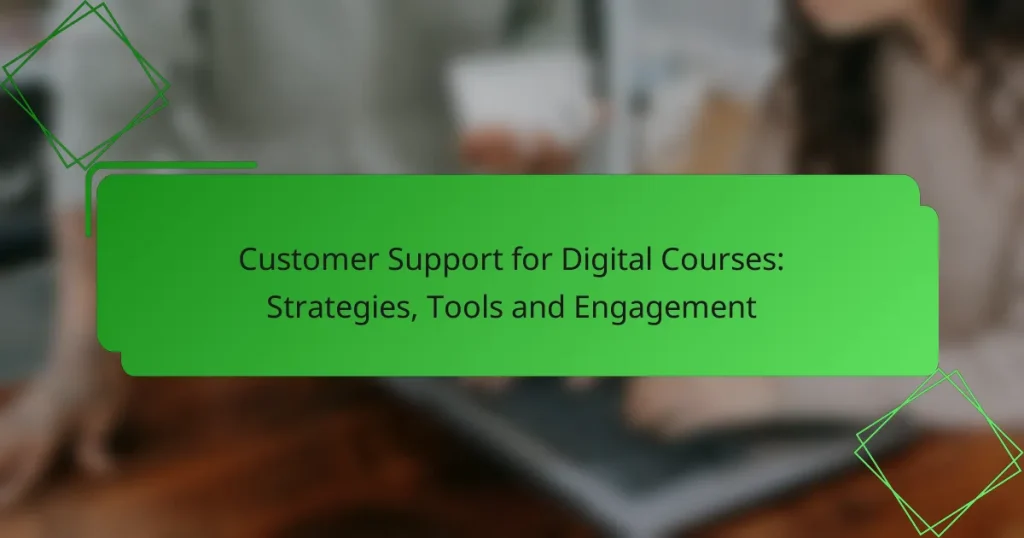In the realm of digital courses, effective customer support is essential for enhancing the learner’s experience through clear communication and personalized assistance. By utilizing specialized tools and fostering active engagement, course providers can significantly boost satisfaction and retention rates. Implementing strategies that encourage interaction and responsiveness not only supports learners but also creates a vibrant educational environment.

What are effective customer support strategies for digital courses?
Effective customer support strategies for digital courses focus on enhancing the learner’s experience through clear communication, personalized assistance, and active engagement. By implementing these strategies, course providers can significantly improve satisfaction and retention rates.
Proactive communication
Proactive communication involves reaching out to learners before they encounter issues, ensuring they feel supported throughout their course journey. This can include sending reminders about upcoming deadlines, providing tips for course navigation, and sharing updates on new content or features.
Consider using automated emails or notifications to keep learners informed. Regular check-ins can help identify potential challenges early, allowing for timely interventions that enhance the overall learning experience.
Personalized assistance
Personalized assistance tailors support to the individual needs of each learner, making them feel valued and understood. This can be achieved through one-on-one coaching sessions, personalized feedback on assignments, or dedicated support channels for specific queries.
Utilizing data analytics can help identify common learner profiles and their unique challenges, enabling support teams to offer customized solutions. This approach not only resolves issues more effectively but also fosters a stronger connection between learners and the course provider.
Feedback loops
Feedback loops are essential for continuous improvement in customer support for digital courses. Regularly soliciting feedback from learners about their experiences can provide valuable insights into what is working and what needs enhancement.
Consider implementing surveys or feedback forms after key milestones in the course. Analyzing this data can help identify trends and areas for improvement, ensuring that support evolves to meet learner needs effectively.
Community engagement
Community engagement fosters a sense of belonging among learners, encouraging them to support each other and share experiences. Creating forums, discussion groups, or social media channels can facilitate interaction and collaboration among course participants.
Encourage learners to ask questions and share insights within these communities. This not only enhances the learning experience but also reduces the burden on support teams by allowing learners to help each other with common issues.

Which tools enhance customer support for digital courses?
Several tools can significantly enhance customer support for digital courses by streamlining communication and improving user experience. Key platforms like Zendesk, Intercom, Teachable, and Slack each offer unique features tailored to address specific support needs.
Zendesk for ticketing
Zendesk is a robust ticketing system that helps manage customer inquiries efficiently. It allows course creators to track, prioritize, and respond to support requests in an organized manner, ensuring no query goes unanswered.
Consider integrating Zendesk with your course platform to automate ticket creation from emails or chat messages. This can reduce response times and improve customer satisfaction.
Intercom for live chat
Intercom provides a live chat solution that enables real-time communication with learners. This tool is particularly effective for addressing immediate concerns or questions during the course experience.
Utilizing Intercom’s automated messaging features can help guide users through common issues, while live agents can handle more complex inquiries. Ensure your team is trained to respond promptly to maximize engagement.
Teachable for course management
Teachable is an all-in-one platform that not only hosts courses but also includes built-in customer support tools. It allows course creators to manage student inquiries directly within the platform, streamlining the support process.
Leverage Teachable’s analytics to identify common student issues and improve your course content accordingly. This proactive approach can enhance the overall learning experience and reduce support requests.
Slack for community support
Slack serves as an effective platform for community support, fostering interaction among learners. By creating dedicated channels for different topics, you can facilitate peer-to-peer support and build a sense of community.
Encourage course participants to share their experiences and solutions within Slack. This not only reduces the burden on your support team but also enhances learner engagement and satisfaction.

How can engagement be improved in digital course customer support?
Engagement in digital course customer support can be enhanced by fostering interactive communication, providing regular updates, and incorporating gamification techniques. These strategies create a more dynamic and responsive environment for learners, encouraging them to participate actively and seek assistance when needed.
Interactive Q&A sessions
Hosting interactive Q&A sessions allows learners to ask questions in real-time, fostering a sense of community and support. These sessions can be scheduled weekly or bi-weekly, providing consistent opportunities for engagement. Consider using platforms like Zoom or Google Meet to facilitate these discussions, ensuring that all participants can easily join.
To maximize effectiveness, prepare a list of common questions in advance and encourage participants to submit their queries beforehand. This preparation can help streamline the session and ensure that key topics are covered.
Regular updates and newsletters
Sending regular updates and newsletters keeps learners informed about course developments, new resources, and upcoming events. Aim for a monthly schedule to maintain consistent communication without overwhelming recipients. Use engaging subject lines and concise content to capture attention and encourage reading.
Including tips, success stories, and highlights from the community can further enhance the value of these communications. Consider using email marketing tools like Mailchimp or Constant Contact to manage your newsletters effectively.
Gamification of support
Gamification involves integrating game-like elements into the support experience to boost engagement. This can include rewards for participation, such as badges or points for asking questions or attending sessions. Establish a leaderboard to encourage friendly competition among learners, motivating them to engage more actively.
When implementing gamification, ensure that the rewards are meaningful and relevant to the learning experience. Simple recognition can be powerful, so consider celebrating achievements in newsletters or during Q&A sessions to reinforce positive behavior.

What are the key criteria for selecting customer support tools?
When selecting customer support tools for digital courses, prioritize scalability, integration capabilities, and user-friendly interfaces. These criteria ensure that the tools can grow with your audience, seamlessly connect with your existing platforms, and provide an intuitive experience for both support staff and learners.
Scalability for growing audiences
Scalability is crucial as your audience expands. Choose tools that can handle increasing volumes of inquiries without compromising response times or service quality. Look for solutions that offer tiered pricing plans, allowing you to upgrade as your user base grows.
Consider tools that provide automated responses or chatbots to manage common questions, which can significantly reduce the workload on your support team. This way, you can maintain high service levels even during peak times.
Integration capabilities with course platforms
Integration capabilities are essential for ensuring that your customer support tools work seamlessly with your course management systems. Look for tools that can easily connect with platforms like Moodle, Teachable, or Thinkific, allowing for streamlined communication and data sharing.
Evaluate whether the tool supports APIs or has pre-built integrations. This can save time and reduce the complexity of managing multiple systems. A well-integrated support tool can enhance the user experience by providing quick access to course-related information.
User-friendly interfaces
A user-friendly interface is vital for both support agents and learners. Tools should be intuitive, allowing support staff to navigate easily and respond quickly to inquiries. A clean layout with clear options can significantly enhance efficiency.
Additionally, consider the end-user experience. Support tools should allow learners to find answers easily, whether through a knowledge base, FAQs, or live chat options. A positive user experience can lead to higher satisfaction and retention rates among your course participants.

How to measure the effectiveness of customer support?
To measure the effectiveness of customer support, focus on key performance indicators (KPIs) that reflect customer experience and operational efficiency. These metrics help identify strengths and areas for improvement in your support services.
Customer satisfaction surveys
Customer satisfaction surveys are essential tools for gauging how well your support team meets user needs. These surveys can be conducted through email, in-app prompts, or after support interactions, asking customers to rate their experience on a scale.
Consider using a mix of quantitative questions (like rating scales) and qualitative feedback (open-ended questions) to gather comprehensive insights. Aim for a response rate of at least 20-30% to ensure the data is representative.
Response time analytics
Response time analytics track how quickly your support team addresses customer inquiries. This metric is crucial as faster responses often correlate with higher customer satisfaction.
Monitor average response times across different channels, such as email, chat, and phone. Aiming for initial responses within a few minutes for chat and under one hour for email can significantly enhance customer perception of your service.
Support ticket resolution rates
Support ticket resolution rates indicate the percentage of issues resolved successfully within a specific timeframe. High resolution rates suggest effective support processes, while low rates may highlight challenges in your system.
To improve this metric, analyze common issues and streamline workflows. Aim for resolution within 24 hours for most inquiries, and consider categorizing tickets by complexity to better allocate resources.

What are common challenges in digital course customer support?
Digital course customer support often faces challenges such as high volumes of inquiries, varied customer expectations, and the need for timely responses. Addressing these issues effectively is crucial for maintaining customer satisfaction and ensuring a smooth learning experience.
High volume of inquiries
A high volume of inquiries can overwhelm customer support teams, leading to longer response times and potential dissatisfaction among learners. This challenge is particularly pronounced during course launches or promotional periods when interest peaks.
To manage a large influx of questions, consider implementing a tiered support system. This allows basic inquiries to be handled by automated systems or FAQs, while more complex issues are escalated to human agents. Tools like chatbots can efficiently address common questions, freeing up staff for more intricate concerns.
Additionally, setting clear expectations regarding response times can help mitigate frustration. For instance, informing customers that they can expect a reply within 24 to 48 hours can reduce anxiety and improve their overall experience. Regularly updating FAQs based on common inquiries can also streamline support efforts.


